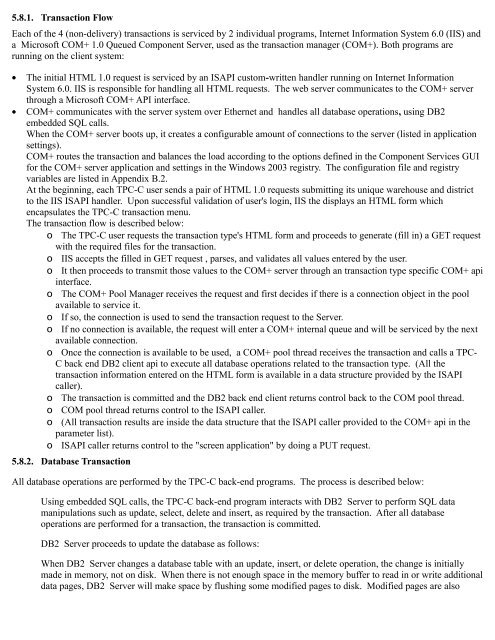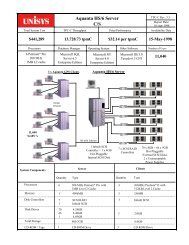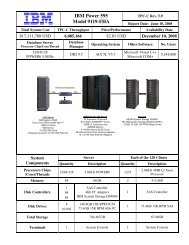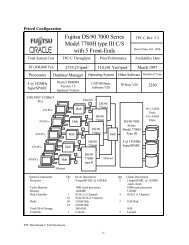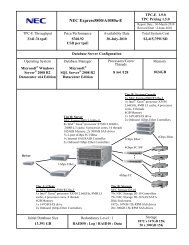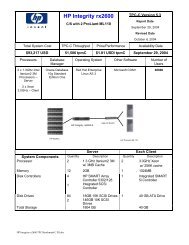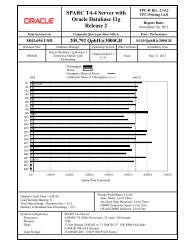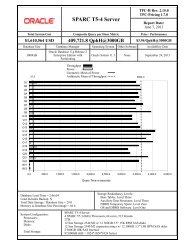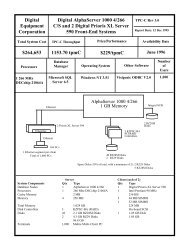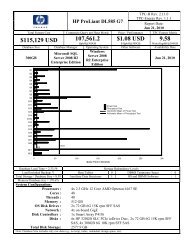- Page 1 and 2: IBM Flex System x240UsingDB2 9.7 En
- Page 3: IBM Flex System x240 w/DB2® v9.7TP
- Page 6 and 7: Table of Contents0. General Items .
- Page 8 and 9: AbstractThis report documents the f
- Page 10 and 11: 0. General Items0.1. Application Co
- Page 12 and 13: 1. Clause 1: Logical Data Base Desi
- Page 14 and 15: 2.8. Home and Remote Payment Transa
- Page 16 and 17: 3. Clause 3: Transaction and System
- Page 18 and 19: Failure of Log Controller:This test
- Page 20 and 21: 4. Clause 4: Scaling and Data Base
- Page 22 and 23: dev/disk/by-id/wwn-0x60080e50002360
- Page 24 and 25: 10 ts_N11 is_O12 is_CTable 4-4: IBM
- Page 26 and 27: 5. Clause 5: Performance Metrics an
- Page 28 and 29: 80000007000000Avg = 0.2676000000500
- Page 30 and 31: 5.5. Think Time Frequency Distribut
- Page 34 and 35: 6. Clause 6: SUT, Driver, and Commu
- Page 36 and 37: 7.3. Availability DatesThe committe
- Page 38: 8. Clause 9: Audit Related ItemsIf
- Page 43 and 44: * tpcccli.sqc - Client/Server code
- Page 45 and 46: C_CREDIT_LIM}else{;COMMIT ;END COMP
- Page 47 and 48: ## Makefile - Makefile for Src.Comm
- Page 49 and 50: }fprintf(err_fp, "-----------------
- Page 51 and 52: }fprintf(debug_fp,"in_payment_struc
- Page 53 and 54: struct out_delivery_struct {int16_t
- Page 55 and 56: **** US Government Users Restricted
- Page 57 and 58: {char *filename,char *msg)FILE *deb
- Page 59 and 60: *----------------------------------
- Page 61 and 62: , D_ID SMALLINT, C_LAST VARCHAR(16)
- Page 63 and 64: , W_CITY CHAR(20), W_STATE CHAR(2),
- Page 65 and 66: END%;, VAR.I_DATA, VAR.OL_DIST_INFO
- Page 67 and 68: ;) AS INSEXEC SQL DECLARE ISOL_Remo
- Page 69 and 70: ;) AS INS, S_QUANTITY SMALLINT )SEL
- Page 71 and 72: :id8 , :ol_quantity8 , :supply_w_id
- Page 73 and 74: ;) AS INSFROM DATAEXEC SQL DECLARE
- Page 75 and 76: ;) AS INSSELECT O_ID, D_ID, W_ID, O
- Page 77 and 78: :ol_quantity12 )))) AS ITEMLIST, TA
- Page 79 and 80: EXEC SQL OPEN ISOL_Local_7 ;NEW_CUR
- Page 81 and 82: 8,8,8,8,8,8,8,8,8,8, /*20-29*/8,8,8
- Page 83 and 84:
to deadlock in this case would roll
- Page 85 and 86:
int16_t pad[SPGENERAL_PAD];int32_t
- Page 87 and 88:
10. Tunable Parameters10.1. Databas
- Page 89 and 90:
11713315036223854708610211813415137
- Page 91 and 92:
[HKEY_LOCAL_MACHINE\SYSTEM\CurrentC
- Page 93 and 94:
"LeaseTerminatesTime"=dword:0000000
- Page 95 and 96:
[HKEY_LOCAL_MACHINE\SYSTEM\CurrentC
- Page 97 and 98:
find . -name zio_timer | xargs -I '
- Page 99 and 100:
# cleanup and unpack the database d
- Page 101 and 102:
connect to TPCC in share mode;drop
- Page 103 and 104:
using ( device '/dev/tpcc/W_048' 25
- Page 105 and 106:
using ( device '/dev/tpcc/W_084' 25
- Page 107 and 108:
using ( device '/dev/tpcc/W_120' 25
- Page 109 and 110:
using ( device '/dev/tpcc/D_036' 10
- Page 111 and 112:
using ( device '/dev/tpcc/D_072' 10
- Page 113 and 114:
using ( device '/dev/tpcc/D_108' 10
- Page 115 and 116:
CRTS_S_024.ddlconnect to TPCC in sh
- Page 117 and 118:
using ( device '/dev/tpcc/S_060' 95
- Page 119 and 120:
using ( device '/dev/tpcc/S_096' 95
- Page 121 and 122:
using ( device '/dev/tpcc/C_012' 68
- Page 123 and 124:
using ( device '/dev/tpcc/C_048' 68
- Page 125 and 126:
using ( device '/dev/tpcc/C_084' 68
- Page 127 and 128:
using ( device '/dev/tpcc/C_120' 68
- Page 129 and 130:
using ( device '/dev/tpcc/O_036' 21
- Page 131 and 132:
using ( device '/dev/tpcc/O_072' 21
- Page 133 and 134:
using ( device '/dev/tpcc/O_108' 21
- Page 135 and 136:
using ( device '/dev/tpcc/OL_024' 5
- Page 137 and 138:
using ( device '/dev/tpcc/OL_060' 5
- Page 139 and 140:
using ( device '/dev/tpcc/OL_096' 5
- Page 141 and 142:
using ( device '/dev/tpcc/N_012' 10
- Page 143 and 144:
using ( device '/dev/tpcc/N_048' 10
- Page 145 and 146:
using ( device '/dev/tpcc/N_084' 10
- Page 147 and 148:
using ( device '/dev/tpcc/N_120' 10
- Page 149 and 150:
using ( device '/dev/tpcc/H_036' 16
- Page 151 and 152:
using ( device '/dev/tpcc/H_072' 16
- Page 153 and 154:
using ( device '/dev/tpcc/H_108' 16
- Page 155 and 156:
using ( device '/dev/tpcc/O2_024' 1
- Page 157 and 158:
using ( device '/dev/tpcc/O2_060' 1
- Page 159 and 160:
using ( device '/dev/tpcc/O2_096' 1
- Page 161 and 162:
using ( device '/dev/tpcc/C2_012' 2
- Page 163 and 164:
using ( device '/dev/tpcc/C2_048' 2
- Page 165 and 166:
using ( device '/dev/tpcc/C2_084' 2
- Page 167 and 168:
using ( device '/dev/tpcc/C2_120' 2
- Page 169 and 170:
alter tablespace H_001 prefetchsize
- Page 171 and 172:
alter tablespace OL_008 prefetchsiz
- Page 173 and 174:
alter tablespace W_016 prefetchsize
- Page 175 and 176:
connect reset;W_ID STARTING FROM 10
- Page 177 and 178:
DROP TABLE WAREHOUSE27;CREATE TABLE
- Page 179 and 180:
connect reset;W_ZIP CHAR(9) NOT NUL
- Page 181 and 182:
connect reset;W_ID STARTING FROM 59
- Page 183 and 184:
DROP TABLE WAREHOUSE73;CREATE TABLE
- Page 185 and 186:
connect reset;W_ZIP CHAR(9) NOT NUL
- Page 187 and 188:
connect reset;W_ID STARTING FROM 10
- Page 189 and 190:
DROP TABLE WAREHOUSE119;CREATE TABL
- Page 191 and 192:
CRTB_DISTRICT13.ddlconnect to TPCC
- Page 193 and 194:
connect reset;D_W_ID INTEGER NOT NU
- Page 195 and 196:
connect reset;(D_NEXT_O_ID INTEGER
- Page 197 and 198:
connect reset;D_ID STARTING FROM 1
- Page 199 and 200:
connect reset;D_STREET_1 CHAR(20) N
- Page 201 and 202:
CRTB_DISTRICT81.ddlconnect to TPCC
- Page 203 and 204:
connect reset;D_W_ID INTEGER NOT NU
- Page 205 and 206:
connect reset;(D_NEXT_O_ID INTEGER
- Page 207 and 208:
CRTB_STOCK1.ddlconnect to TPCC in s
- Page 209 and 210:
CREATE TABLE STOCK12(S_REMOTE_CNT I
- Page 211 and 212:
connect reset;S_YTD INTEGER NOT NUL
- Page 213 and 214:
connect reset;S_DIST_04 CHAR(24) NO
- Page 215 and 216:
connect reset;S_DIST_08 CHAR(24) NO
- Page 217 and 218:
connect reset;)IN S_056INDEX IN S_0
- Page 219 and 220:
connect reset;S_W_ID STARTING FROM
- Page 221 and 222:
CRTB_STOCK79.ddlconnect to TPCC in
- Page 223 and 224:
CREATE TABLE STOCK90(S_REMOTE_CNT I
- Page 225 and 226:
connect reset;S_YTD INTEGER NOT NUL
- Page 227 and 228:
connect reset;S_DIST_04 CHAR(24) NO
- Page 229 and 230:
connect reset;C_ZIP CHAR(9) NOT NUL
- Page 231 and 232:
connect reset;)ALLOW OVERFLOW;CRTB_
- Page 233 and 234:
connect reset;C_W_ID INTEGER NOT NU
- Page 235 and 236:
connect reset;C_PHONE CHAR(16) NOT
- Page 237 and 238:
connect reset;ALLOW OVERFLOW;CRTB_C
- Page 239 and 240:
connect reset;C_DELIVERY_CNT INTEGE
- Page 241 and 242:
connect reset;C_PHONE CHAR(16) NOT
- Page 243 and 244:
connect reset;ALLOW OVERFLOW;CRTB_C
- Page 245 and 246:
connect reset;C_DELIVERY_CNT INTEGE
- Page 247 and 248:
connect reset;C_PHONE CHAR(16) NOT
- Page 249 and 250:
connect reset;ALLOW OVERFLOW;CRTB_C
- Page 251 and 252:
connect reset;C_DELIVERY_CNT INTEGE
- Page 253 and 254:
connect reset;C_PHONE CHAR(16) NOT
- Page 255 and 256:
CRTB_ORDERS13.ddlconnect to TPCC in
- Page 257 and 258:
connect reset;INDEX IN O2_027ORGANI
- Page 259 and 260:
connect reset;O_CARRIER_ID SMALLINT
- Page 261 and 262:
CRTB_ORDERS57.ddlconnect to TPCC in
- Page 263 and 264:
connect reset;INDEX IN O2_071ORGANI
- Page 265 and 266:
connect reset;O_CARRIER_ID SMALLINT
- Page 267 and 268:
CRTB_ORDERS101.ddlconnect to TPCC i
- Page 269 and 270:
connect reset;INDEX IN O2_115ORGANI
- Page 271 and 272:
connect reset;OL_QUANTITY SMALLINT
- Page 273 and 274:
connect reset;OL_W_ID INTEGER NOT N
- Page 275 and 276:
connect reset;INDEX IN OL_035ORGANI
- Page 277 and 278:
connect reset;OL_O_ID STARTING FROM
- Page 279 and 280:
connect reset;CRTB_ORDER_LINE62.ddl
- Page 281 and 282:
connect to TPCC in share mode;DROP
- Page 283 and 284:
connect reset;OL_DELIVERY_D TIMESTA
- Page 285 and 286:
connect reset;OL_QUANTITY SMALLINT
- Page 287 and 288:
connect reset;OL_W_ID INTEGER NOT N
- Page 289 and 290:
connect reset;NO_O_ID INTEGER NOT N
- Page 291 and 292:
connect reset;NO_D_ID STARTING FROM
- Page 293 and 294:
connect to TPCC in share mode;DROP
- Page 295 and 296:
connect reset;IN N_065INDEX IN N_06
- Page 297 and 298:
connect reset;CRTB_NEW_ORDER84.ddlc
- Page 299 and 300:
connect reset;NO_O_ID INTEGER NOT N
- Page 301 and 302:
connect reset;NO_D_ID STARTING FROM
- Page 303 and 304:
connect to TPCC in share mode;DROP
- Page 305 and 306:
H_W_ID INTEGER NOT NULL,H_DATE TIME
- Page 307 and 308:
connect reset;CRTB_HISTORY56.ddlcon
- Page 309 and 310:
H_C_ID INTEGER NOT NULL,H_C_D_ID SM
- Page 311 and 312:
)IN H_092INDEX IN H_092;ALTER TABLE
- Page 313 and 314:
connect to TPCC in share mode;DROP
- Page 315 and 316:
autobench/sources/db2_tpcc-1/users/
- Page 317 and 318:
autobench/sources/db2_tpcc-1/users/
- Page 319 and 320:
autobench/sources/db2_tpcc-1/users/
- Page 321 and 322:
autobench/sources/db2_tpcc-1/users/
- Page 323 and 324:
autobench/sources/db2_tpcc-1/users/
- Page 325 and 326:
autobench/sources/db2_tpcc-1/users/
- Page 327 and 328:
autobench/sources/db2_tpcc-1/users/
- Page 329 and 330:
autobench/sources/db2_tpcc-1/users/
- Page 331 and 332:
autobench/sources/db2_tpcc-1/users/
- Page 333 and 334:
autobench/sources/db2_tpcc-1/users/
- Page 335 and 336:
autobench/sources/db2_tpcc-1/users/
- Page 337 and 338:
autobench/sources/db2_tpcc-1/users/
- Page 339 and 340:
IMPORT FROM /database/flats/flat30/
- Page 341 and 342:
IMPORT FROM /database/flats/flat70/
- Page 343 and 344:
IMPORT FROM /database/flats/flat110
- Page 345 and 346:
IMPORT FROM /database/flats/flat30/
- Page 347 and 348:
IMPORT FROM /database/flats/flat70/
- Page 349 and 350:
IMPORT FROM /database/flats/flat110
- Page 351 and 352:
IMPORT FROM /database/flats/flat24/
- Page 353 and 354:
IMPORT FROM /database/flats/flat57/
- Page 355 and 356:
IMPORT FROM /database/flats/flat90/
- Page 357 and 358:
IMPORT FROM /database/flats/flat3/c
- Page 359 and 360:
IMPORT FROM /database/flats/flat36/
- Page 361 and 362:
IMPORT FROM /database/flats/flat69/
- Page 363 and 364:
IMPORT FROM /database/flats/flat102
- Page 365 and 366:
IMPORT FROM /database/flats/flat15/
- Page 367 and 368:
IMPORT FROM /database/flats/flat48/
- Page 369 and 370:
IMPORT FROM /database/flats/flat81/
- Page 371 and 372:
IMPORT FROM /database/flats/flat114
- Page 373 and 374:
IMPORT FROM /database/flats/flat27/
- Page 375 and 376:
IMPORT FROM /database/flats/flat60/
- Page 377 and 378:
IMPORT FROM /database/flats/flat93/
- Page 379 and 380:
CONNECT RESET;LOAD_NEW_ORDER8_1.ddl
- Page 381 and 382:
IMPORT FROM /database/flats/flat48/
- Page 383 and 384:
IMPORT FROM /database/flats/flat88/
- Page 385 and 386:
LOAD FROM /database/flats/flat10/hi
- Page 387 and 388:
LOAD FROM /database/flats/flat62/hi
- Page 389 and 390:
LOAD FROM /database/flats/flat114/h
- Page 391 and 392:
ALTER TABLE WAREHOUSE36 DROP CONSTR
- Page 393 and 394:
CRCONST_WAREHOUSE77.ddlconnect to T
- Page 395 and 396:
SET INTEGRITY FOR WAREHOUSE115 OFF;
- Page 397 and 398:
ALTER TABLE DISTRICT35 DROP CONSTRA
- Page 399 and 400:
CRCONST_DISTRICT76.ddlconnect to TP
- Page 401 and 402:
ALTER TABLE DISTRICT114 DROP CONSTR
- Page 403 and 404:
ALTER TABLE STOCK34 DROP CONSTRAINT
- Page 405 and 406:
CRCONST_STOCK75.ddlconnect to TPCC
- Page 407 and 408:
ALTER TABLE STOCK115 ADD CONSTRAINT
- Page 409 and 410:
connect to TPCC in share mode;SET I
- Page 411 and 412:
SET INTEGRITY FOR CUSTOMER76 ALL IM
- Page 413 and 414:
ALTER TABLE CUSTOMER114 ADD CONSTRA
- Page 415 and 416:
ALTER TABLE ORDERS34 DROP CONSTRAIN
- Page 417 and 418:
CRCONST_ORDERS75.ddlconnect to TPCC
- Page 419 and 420:
ALTER TABLE ORDERS115 ADD CONSTRAIN
- Page 421 and 422:
ALTER TABLE ORDER_LINE32 ADD CONSTR
- Page 423 and 424:
ALTER TABLE ORDER_LINE68 ADD CONSTR
- Page 425 and 426:
ALTER TABLE ORDER_LINE104 ADD CONST
- Page 427 and 428:
CRCONST_NEW_ORDER22.ddlconnect to T
- Page 429 and 430:
ALTER TABLE NEW_ORDER58 ADD CONSTRA
- Page 431 and 432:
ALTER TABLE NEW_ORDER94 ADD CONSTRA
- Page 433 and 434:
CRCONST_HISTORY12.ddlconnect to TPC
- Page 435 and 436:
ALTER TABLE HISTORY52 ADD CONSTRAIN
- Page 437 and 438:
connect to TPCC in share mode;SET I
- Page 439 and 440:
CRIDX_CUST_IDXB13.ddlconnect to TPC
- Page 441 and 442:
connect reset;CRIDX_CUST_IDXB59.ddl
- Page 443 and 444:
connect to TPCC in share mode;DROP
- Page 445 and 446:
PCTFREE 20;connect reset;CRIDX_ORDR
- Page 447 and 448:
PCTFREE 20;connect reset;CRIDX_ORDR
- Page 449 and 450:
PCTFREE 20;connect reset;ON ORDERS1
- Page 451 and 452:
connect to TPCC in share mode;RUNST
- Page 453 and 454:
connect to TPCC in share mode;RUNST
- Page 455 and 456:
connect to TPCC in share mode;RUNST
- Page 457 and 458:
connect to TPCC in share mode;RUNST
- Page 459 and 460:
connect to TPCC in share mode;RUNST
- Page 461 and 462:
connect to TPCC in share mode;RUNST
- Page 463 and 464:
connect to TPCC in share mode;RUNST
- Page 465 and 466:
connect to TPCC in share mode;RUNST
- Page 467 and 468:
connect to TPCC in share mode;RUNST
- Page 469 and 470:
connect to TPCC in share mode;RUNST
- Page 471 and 472:
connect to TPCC in share mode;RUNST
- Page 473 and 474:
connect to TPCC in share mode;RUNST
- Page 475 and 476:
connect to TPCC in share mode;RUNST
- Page 477 and 478:
connect to TPCC in share mode;RUNST
- Page 479 and 480:
connect to TPCC in share mode;RUNST
- Page 481 and 482:
connect to TPCC in share mode;RUNST
- Page 483 and 484:
connect to TPCC in share mode;RUNST
- Page 485 and 486:
connect to TPCC in share mode;RUNST
- Page 487 and 488:
alter tablespace C2_057 prefetchsiz
- Page 489 and 490:
alter tablespace H_065 prefetchsize
- Page 491 and 492:
alter tablespace OL_072 prefetchsiz
- Page 493 and 494:
alter tablespace W_080 prefetchsize
- Page 495 and 496:
ALTER TABLESPACE D_045 BUFFERPOOL D
- Page 497 and 498:
ALTER TABLESPACE C2_076 BUFFERPOOL
- Page 499 and 500:
ALTER TABLESPACE O2_108 BUFFERPOOL
- Page 501 and 502:
ALTER BUFFERPOOL HST4 DEFERRED SIZE
- Page 503 and 504:
INCLUDE =-I$(TPCC_SQLLIB)/include -
- Page 505 and 506:
dbgen/gendata.c/*******************
- Page 507 and 508:
exit(-1);}if (option == 9 && (outty
- Page 509 and 510:
create_random_a_string( stock_dist_
- Page 511 and 512:
create_random_n_string( dist_zip, 4
- Page 513 and 514:
c = GenericClose(&hnd);cust_done:}t
- Page 515 and 516:
*----------------------------------
- Page 517 and 518:
"ABLE","PRI","PRES","ESE","ANTI","C
- Page 519 and 520:
** create a random numeric string,
- Page 521 and 522:
#ifndef __PLATFORM_H#define __PLATF
- Page 523 and 524:
IOH_DELETE(hnd)IOH_ERRMSG(hnd, "del
- Page 526:
12. Appendix D: Pricing


